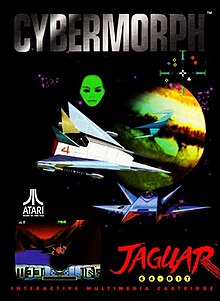
The Atari Jaguar is a home video game console developed by Atari Corporation and released in North America in November 1993. Part of the fifth generation of video game consoles, it competed with the 16-bit Sega Genesis, the Super NES and the 32-bit 3DO Interactive Multiplayer that launched the same year. Powered by two custom 32-bit processors – Tom and Jerry – in addition to a Motorola 68000, Atari marketed it as the world's first 64-bit game system, emphasizing its 64-bit bus used by the blitter. The Jaguar launched with Cybermorph as the pack-in game, which received divisive reviews. The system's library ultimately comprised only 50 licensed games.
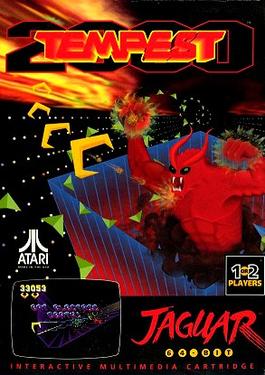
Tempest 2000 is a tube shooter video game originally developed by Llamasoft and published by Atari Corporation for the Atari Jaguar in North America on 13 April, 1994. It was released in Europe on 27 June and in Japan on 15 December of the same year, with the Japanese release being published by Mumin Corporation. Part of Atari Corp.'s 2000 series, it is a remake by Jeff Minter of Dave Theurer's 1981 arcade game Tempest, which used Atari's QuadraScan vector color display technology.
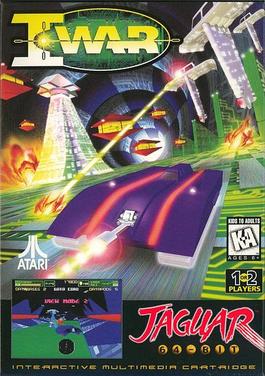
I-War is a 1995 shooter video game developed by Imagitec Design and published by Atari Corporation for the Atari Jaguar. The plot takes place in a futuristic setting where the mainframe supercomputer Override begins to mutate databases and create computer viruses. The player is tasked with piloting an antivirus tank vehicle to eliminate mutated databases and viruses clogging the I-Way network, while recovering data pods and facing off against a variety of enemies.

Kasumi Ninja is a fighting game, developed by Hand Made Software and published by Atari Corporation. Initially it was for the Atari Jaguar in North America and Europe on December 21, 1994, and was later released in Japan by Messe Sanoh in July 1995. It was the first fighting title to be released for the Jaguar, and unsuccessfully sought to capitalize on the trend of ultra violent fighting games started by Midway Games's Mortal Kombat in 1992.

Alien vs Predator is a 1994 first-person shooter developed by Rebellion Developments and published by Atari Corporation for the Atari Jaguar. It was also distributed in Japan by Mumin Corporation, where it became a pack-in game for the console. It is the first entry in the Alien vs. Predator franchise developed by Rebellion. Taking place in a simulation depicting the fall of the Golgotha training base camp, the game offers three playable scenarios: Alien, Predator, or a human of the Colonial Marines. The player is presented with a series of interconnected sublevels and ships to progress through. Each character has different objectives, abilities, weapons, and disadvantages.

White Men Can't Jump is a 1995 basketball video game developed by High Voltage Software (HVS) and published by Atari for the Atari Jaguar. It is loosely based on the 1992 20th Century Fox film of the same name. The game features a loose version of basketball known as streetball. It can be played against computer-controlled opponents, or up to four human competitors using the Team Tap multitap.
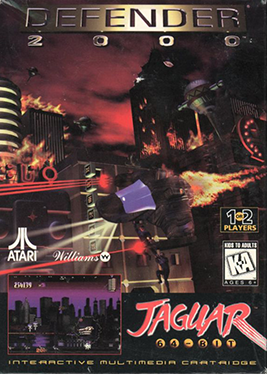
Defender 2000 is a 1996 scrolling shooter video game developed by Llamasoft and published by Atari Corporation for the Atari Jaguar. Part of Atari's 2000 series of arcade game revivals, it is an update of Eugene Jarvis' arcade game Defender (1981). The premise takes place in a future where the Alpha Promixian empire attack mining settlements on distant resource planets. Gameplay is divided into three modes, with the player acting as part of the System Defense Team commanding the Threshold ship to defeat waves of invading aliens while protecting humans.
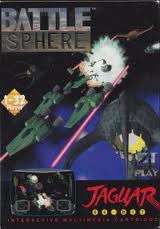
BattleSphere is a space combat simulation video game developed by 4Play for the Atari Jaguar. The game was released in 2000, with the enhanced edition BattleSphere Gold released in 2002. Set during a future war between seven alien races, the factions agree to confine their hostilities to a tournament with the galaxy at stake. Gameplay consists of five modes, each featuring distinct scenarios and objectives. Up to 16 players can participate in a deathmatch mode via local area network (LAN) play.

Brett Hull Hockey is an ice hockey video game developed by Radical Entertainment and originally published by Accolade for the Super Nintendo Entertainment System in North America in January 1994. It prominently features former Canadian-American NHL player Brett Hull and is officially licensed from the NHL Players' Association.
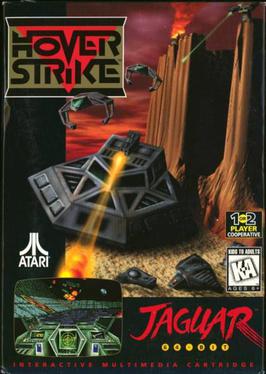
Hover Strike is a shooter video game developed and published by Atari Corporation exclusively for the Atari Jaguar first in North America in April 1995, then in Europe on May of the same year and later in Japan around the same period, where it was published instead by Messe Sansao. Taking place in a future where the Terrakian Pirates have seized control of a colonized foreign planet, players are tasked with piloting an armed hovercraft vehicle in an attempt of rescuing the captured colonists and obliterate the invading alien forces from the surface of the planet before the Federation armada arrives.

Iron Soldier is an open world first-person mecha simulation video game developed by Eclipse Software Design and published by Atari Corporation for the Atari Jaguar in North America and Europe on December 22, 1994, then in Europe in January 1995 and later in Japan on March 24 of the same year, where it was instead published by Mumin Corporation. The first installment in the eponymous franchise, the game is set in a dystopian future where industries and machinery has overrun most of the surface on Earth, as players assume the role of a resistance member taking control of the titular mech in an attempt to overthrow the dictatorship of Iron Fist Corporation, who have conquered the world through usage of military force.

Battlemorph is a 1995 shooter video game developed by Attention to Detail (ATD) and published by Atari Corporation for the Atari Jaguar CD. It is the sequel to Cybermorph (1993), a pack-in game for the Atari Jaguar. Taking place 30 years after the events of the original game, the player pilots the morphing infiltration fighter War Griffon in an extermination mission against the Pernitia empire, which plans to launch a full-scale invasion to eradicate humanity and take over the galaxy after being pushed back to their home planet. The player is tasked with various objectives, while fighting against enemies and bosses, across eight galaxy clusters in order to liberate them from control of the empire.

Trevor McFur in the Crescent Galaxy is a 1993 horizontally scrolling shooter video game developed and published by Atari Corporation for the Atari Jaguar. The game stars Trevor McFur, a corporal in the Interplanetary Defense Squad's Circle Reserves chapter. The Crescent Galaxy has been conquered by an entity known as Odd-It, whose purpose is to make every living being like it. Alongside his partner Cutter piloting a shuttlecraft, McFur must free four moons of the planet Cosmolite and defeat Odd-It.

Bubsy in: Fractured Furry Tales is a platform video game developed by Imagitec Design and published by Atari Corporation for the Atari Jaguar in North America on December 1994, and Europe in January 1995. The third entry in the Bubsy series, the plot follows the titular character, who ventures through a realm of fairy tales to restore order and protect children all over the world from creatures and antagonists of corrupted fairy tales, which appeared after Mother Goose was captured by Hansel and Gretel.

Zero-5 is a shooter video game developed and published by Caspian Software for the Atari STe in 1994. It is one of the last official releases for the Atari ST after being discontinued in 1993 by Atari Corporation.

AirCars is a 1997 shooter video game developed by MidNite Entertainment Group Inc., published in North America by ICD and in France by La Terre du Milieu for the Atari Jaguar. It was one of the last officially licensed releases for the platform. The game follows a government pilot controlling an aircar to stop the E.B.N.E.R.S. organization, which plans to dominate a post-apocalyptic world left by a nuclear holocaust. The player fights against enemies and bosses, while shooting down key targets across 32 missions set on various locations. Two players can also play the main campaign or up to eight players can participate in a deathmatch mode.

Power Drive Rally is a 1995 racing video game developed by Rage Software and published by Time Warner Interactive for the Atari Jaguar. It is a conversion of the 1994 racing game Power Drive, which was released on multiple platforms. Revolving around rallying, the game features six real vehicles and circuits based on eight locations around the world. The players participate in various racing events and earn money by qualifying or winning to continue the rally season and repair damage to the car.
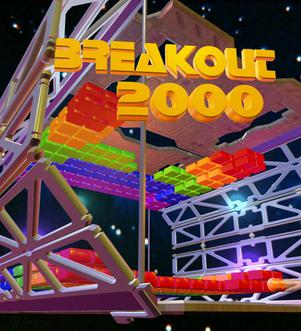
Breakout 2000 is a 1996 action video game developed by MP Games and published by Telegames for the Atari Jaguar. Part of the 2000 series by Atari Corporation, it is a remake of the arcade game Breakout (1976), and one of the last officially licensed releases for the platform. Featuring a similar premise to Breakout, the player must destroy a layer of brick lines by repeatedly bouncing a ball spawned off a paddle into them and keep it in play. Gameplay modifications to the original game include a third-person perspective behind the paddle in a pseudo-3D playfield, power-ups, bonus levels, enemies, varying level designs, and multiplayer features.

Checkered Flag is a 1994 racing video game developed by Rebellion Developments and published by Atari Corporation for the Atari Jaguar. It is a conversion of the 1991 Atari Lynx title of the same name. In the game, the player controls a Formula One car competing against computer-controlled opponents in races across multiple locations. Gameplay consists of three modes, and the player can choose various weather conditions or customize the vehicle's characteristics.

Blue Lightning is a 1995 combat flight simulator video game developed by Attention to Detail and published by Atari Corporation for the Atari Jaguar CD. It is a conversion of Epyx's 1989 Atari Lynx title of the same name, and one of the pack-in games for the Jaguar CD. In the game, the player assume the role of a rookie fighter pilot from the Blue Lightning squadron, taking control of multiple military aircraft across various missions to stop general Drako, who betrayed the United Nations and gained power of military organizations through corruption to expand his organized crime empire all over the world.
